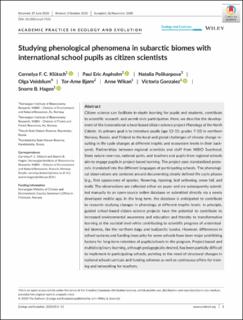| dc.description.abstract | Citizen science can facilitate in‐depth learning for pupils and students, contribute to scientific research, and permit civic participation. Here, we describe the development of the transnational school‐based citizen science project Phenology of the North Calotte. Its primary goal is to introduce pupils (age 12–15; grades 7–10) in northern Norway, Russia, and Finland to the local and global challenges of climate change resulting in life cycle changes at different trophic and ecosystem levels in their backyards. Partnerships between regional scientists and staff from NIBIO Svanhovd, State nature reserves, national parks, and teachers and pupils from regional schools aim to engage pupils in project‐based learning. The project uses standardized protocols, translated into the different languages of participating schools. The phenological observations are centered around documenting clearly defined life cycle phases (e.g., first appearance of species, flowering, ripening, leaf yellowing, snow fall, and melt). The observations are collected either on paper and are subsequently submitted manually to an open‐source online database or submitted directly via a newly developed mobile app. In the long term, the database is anticipated to contribute to research studying changes in phenology at different trophic levels. In principle, guided school‐based citizen science projects have the potential to contribute to increased environmental awareness and education and thereby to transformative learning at the societal level while contributing to scientific progress of understudied biomes, like the northern taiga and (sub)arctic tundra. However, differences in school systems and funding insecurity for some schools have been major prohibiting factors for long‐term retention of pupils/schools in the program. Project‐based and multidisciplinary learning, although pedagogically desired, has been partially difficult to implement in participating schools, pointing to the need of structural changes in national school curricula and funding schemes as well as continuous offers for training and networking for teachers. | en_US |

